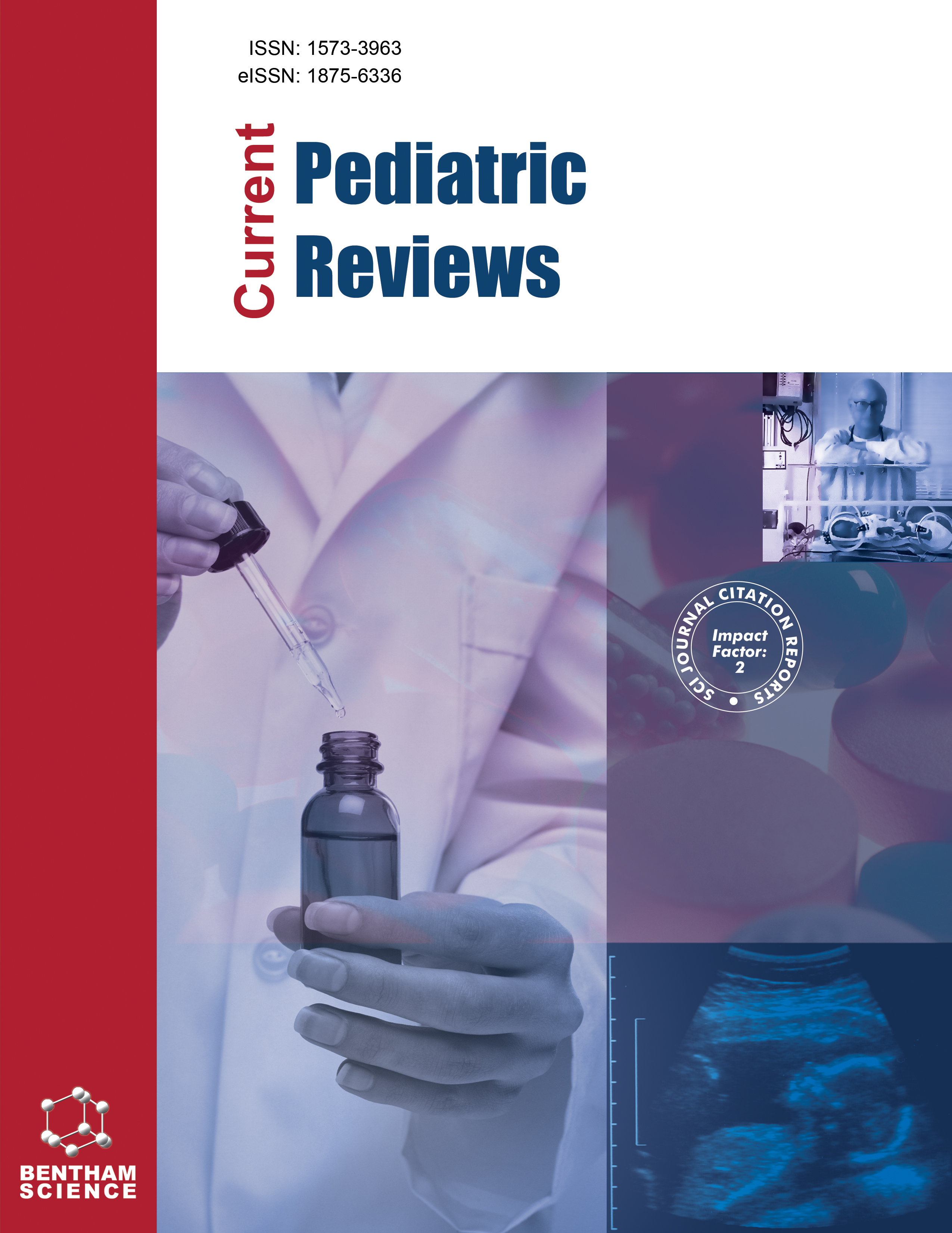- Home
- A-Z Publications
- Current Pediatric Reviews
- Previous Issues
- Volume 19, Issue 4, 2023
Current Pediatric Reviews - Volume 19, Issue 4, 2023
Volume 19, Issue 4, 2023
-
-
The Anemic Newborn at Birth: From Diagnosis to Treatment
More LessNeonatal anaemia is a very frequent clinical condition that may be due to apparent or not evident blood loss, decreased red blood cells (RBCs) production, or increased destruction of RBCs. RBCs transfusion criteria are clearly defined by several national and locally agreed guidelines. However, it is not possible to define a unique cut-off to guide clinicians' transfusion practice, which needs a multiparametric analysis of d Read More
-
-
-
Fresh Frozen Plasma Administration in the NICU: Evidence-based Guidelines
More LessAuthors: Mario Motta and Brunetta GuaragniThe use of FFP in neonatology should be primarily for neonates with active bleeding and associated coagulopathy. However, since there is limited and poor-quality evidence supporting neonatal FFP transfusion, considerable FFP usage continues to be outside of this recommendation, as documented by neonatal transfusion audits. This review updates the scientific evidence available on FFP use in neonatology and reports Read More
-
-
-
Neutropenia in Preterm Infants
More LessBackground: The non-specific and antigen-specific components of host defense mechanisms are subject to the adaptation process in the neonate; however, the neutrophil quantitative and qualitative deficiency is one of the most significant causative factors of neonatal-increased vulnerability to infection. Objective: To review the incidence and outcome of neutropenia of unknown cause in preterm infants. Results: The incidence of Read More
-
-
-
Pitfalls and Limitations of Platelet Counts and Coagulation Tests in the Neonatal Intensive Care Unit
More LessAuthors: Patricia Davenport and Martha Sola-VisnerThe assessment of hemostasis and the prediction of bleeding risk are of great importance to neonatologists. Premature infants are at an increased risk for bleeding, particularly intra-cranial hemorrhages (most commonly intra-ventricular hemorrhages (IVH)), gastrointestinal hemorrhages, and pulmonary hemorrhages. All severe bleeding, but especially severe IVH, is associated with poor neurodevelopmental outcomes, and oth Read More
-
-
-
Severe Thromboses in Neonates
More LessAuthors: Matthew A. Saxonhouse and Ashley HinsonSevere thrombosis in the neonate presents a diagnostic challenge to the clinician as the benefits and risks for treatment must be weighed with every medical decision. Aortic thromboses, large right atrial thromboses, and septic thrombophlebitis present unique clinical challenges that must be managed in the appropriate clinical setting with appropriate subspecialty support. Unfortunately, there is limited data on what the ide Read More
-
-
-
Cord Blood Sampling - A Review of Umbilical Cord Blood Use for Admission Laboratory Tests in the Immediate Newborn Period
More LessHistorically blood for admission laboratory studies in neonates was obtained through direct neonatal phlebotomy. Over the past decade, there has been a significant increase in studies evaluating the validity and clinical impact of using a cord blood sample for many admission laboratory studies. This article reviews various studies that together suggest that using cord blood samples for admission testing in neonates is both accept Read More
-
-
-
Perinatal Hemolytic Disorders and Identification Using End Tidal Breath Carbon Monoxide
More LessHemolytic disorders can cause severe morbidity or can be life-threatening. Before the recent development of practical and inexpensive testing for hemolysis by quantifying carbon monoxide in end-tidal breath, some hemolytic disorders in perinatal patients were not detected until severely problematic hyperbilirubinemia and/or anemia occurred. Here we review studies aimed at establishing the normal reference intervals fo Read More
-
-
-
Neonatal Anemia
More LessAuthors: Kendell R. German and Sandra E. JuulAll neonates experience a downtrend in their hematocrit values immediately following the birth through normal falls in erythropoietin (Epo) production, transition to adult hemoglobin, and hemodilution with somatic growth. However, this drop is more pronounced in critically ill and preterm neonates and can lead to potentially pathologic anemia that impairs tissue oxygen delivery. In this review, we highlight the mec Read More
-
-
-
Mitochondria in Early Life
More LessAuthors: Ling He and Akhil MaheshwariMitochondria are highly-dynamic, membrane-bound organelles that generate most of the chemical energy needed to power the biochemical reactions in eukaryotic cells. These organelles also communicate with the nucleus and other cellular structures to help maintain somatic homeostasis, allow cellular adaptation to stress, and help maintain the developmental trajectory. Mitochondria also perform numerous o Read More
-
-
-
Longitudinal Assessment of Preterm Infants Treated with Erythropoiesis Stimulating Agents
More LessAuthors: Robin K. Ohls, Jean Lowe, Ronald A. Yeo, Shrena Patel, Sarah Winter, Richard A. Campbell, Shawna Baker and John PhillipsObjective: We previously reported improved neurodevelopment at 2 and 4 years among preterm infants treated with erythropoietin or darbepoetin, known as erythropoiesis-stimulating agents (ESAs). We now characterize longitudinal outcomes through 6 years. Methods: Children randomized to ESAs or placebo were evaluated at 6 years. Healthy-term children served as controls. Tests of cognition and executive function (EF) wer Read More
-
-
-
Nucleated Red Blood Cell Emergence-Time in Newborn Lambs Following a Dose of Darbepoetin Alfa
More LessBackground: Nucleated red blood cells (NRBC) are very uncommon in the blood of children and adults, but small numbers are not rare in neonates on the day of birth. Elevated NRBC counts in neonates can be seen following erythropoietin dosing. Limited studies in human neonates suggest the time-interval between erythropoietin dosing and the first appearance of NRBC in the blood (the “NRBC emergence-time”) is in excess of Read More
-
Volumes & issues
-
Volume 21 (2025)
-
Volume 20 (2024)
-
Volume 19 (2023)
-
Volume 18 (2022)
-
Volume 17 (2021)
-
Volume 16 (2020)
-
Volume 15 (2019)
-
Volume 14 (2018)
-
Volume 13 (2017)
-
Volume 12 (2016)
-
Volume 11 (2015)
-
Volume 10 (2014)
-
Volume 9 (2013)
-
Volume 8 (2012)
-
Volume 7 (2011)
-
Volume 6 (2010)
-
Volume 5 (2009)
-
Volume 4 (2008)
-
Volume 3 (2007)
-
Volume 2 (2006)
-
Volume 1 (2005)
Most Read This Month
Article
content/journals/cpr
Journal
10
5
false
en


